engine CHEVROLET TRACKER 2001 2.G Manual PDF
[x] Cancel search | Manufacturer: CHEVROLET, Model Year: 2001, Model line: TRACKER, Model: CHEVROLET TRACKER 2001 2.GPages: 391, PDF Size: 2.84 MB
Page 256 of 391

6-4
In Canada, look for the
ªAuto Makers' Choiceº
label on the fuel pump.
Canada Only
Be sure the posted octane is at least 87. If the octane is
less than 87, you may get a heavy knocking noise when
you drive. If it's bad enough, it can damage your engine.
If you're using fuel rated at 87 octane or higher and
you hear heavy knocking, your engine needs service.
But don't worry if you hear a little pinging noise when
you're accelerating or driving up a hill. That's normal,
and you don't have to buy a higher octane fuel to get
rid of pinging. It's the heavy, constant knock that means
you have a problem.If your vehicle is certified to meet California Emission
Standards (indicated on the underhood emission control
label), it is designed to operate on fuels that meet
California specifications. If such fuels are not available
in states adopting California emissions standards,
your vehicle will operate satisfactorily on fuels meeting
federal specifications, but emission control system
performance may be affected. The malfunction indicator
lamp on your instrument panel may turn on and/or your
vehicle may fail a smog
-check test. See ªMalfunction
Indicator Lampº in the Index. If this occurs, return
to your authorized Chevrolet dealer for diagnosis
to determine the cause of failure. In the event it is
determined that the cause of the condition is the type of
fuels used, repairs may not be covered by your warranty.
Some gasolines that are not reformulated for low
emissions may contain an octane
-enhancing additive
called methylcyclopentadienyl manganese tricarbonyl
(MMT); ask your service station operator whether or
not the fuel contains MMT. General Motors does not
recommend the use of such gasolines. If fuels containing
MMT are used, spark plug life may be reduced and your
emission control system performance may be affected.
The malfunction indicator lamp on your instrument
panel may turn on. If this occurs, return to your
authorized Chevrolet dealer for service.
Page 257 of 391
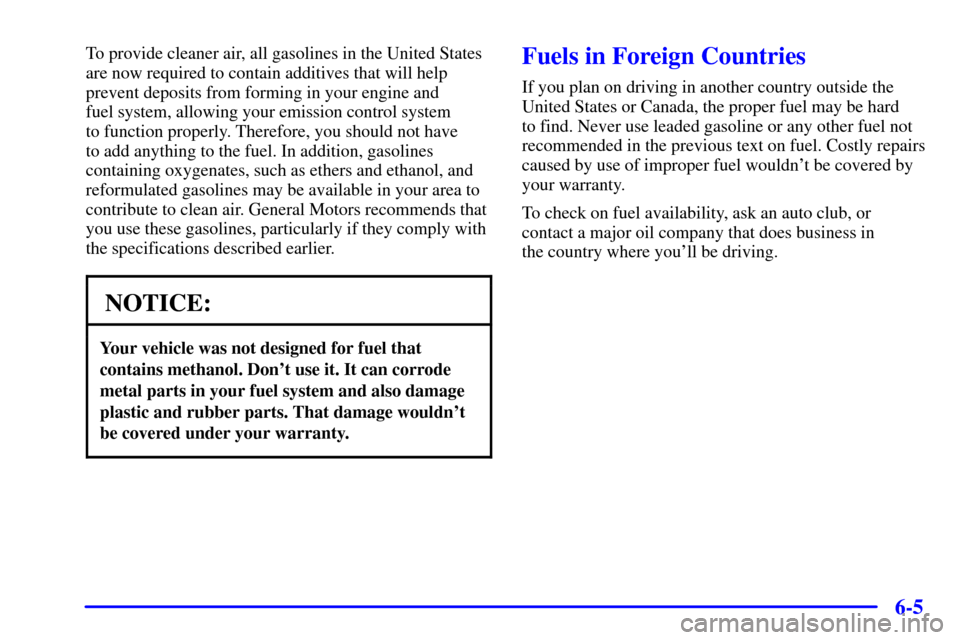
6-5
To provide cleaner air, all gasolines in the United States
are now required to contain additives that will help
prevent deposits from forming in your engine and
fuel system, allowing your emission control system
to function properly. Therefore, you should not have
to add anything to the fuel. In addition, gasolines
containing oxygenates, such as ethers and ethanol, and
reformulated gasolines may be available in your area to
contribute to clean air. General Motors recommends that
you use these gasolines, particularly if they comply with
the specifications described earlier.
NOTICE:
Your vehicle was not designed for fuel that
contains methanol. Don't use it. It can corrode
metal parts in your fuel system and also damage
plastic and rubber parts. That damage wouldn't
be covered under your warranty.
Fuels in Foreign Countries
If you plan on driving in another country outside the
United States or Canada, the proper fuel may be hard
to find. Never use leaded gasoline or any other fuel not
recommended in the previous text on fuel. Costly repairs
caused by use of improper fuel wouldn't be covered by
your warranty.
To check on fuel availability, ask an auto club, or
contact a major oil company that does business in
the country where you'll be driving.
Page 261 of 391

6-9
Checking Things Under the Hood
CAUTION:
An electric fan under the hood can start up and
injure you even when the engine is not running.
Keep hands, clothing and tools away from any
underhood electric fan. Don't reach through
the grille to release the underhood lever.
CAUTION:
Things that burn can get on hot engine parts and
start a fire. These include liquids like fuel, oil,
coolant, brake fluid, windshield washer and other
fluids, and plastic or rubber. You or others could
be burned. Be careful not to drop or spill things
that will burn onto a hot engine.
Hood Release
1. To open the hood, first
pull the release handle
located on the driver's
side of the vehicle on the
lower portion of the
instrument panel.
Page 263 of 391
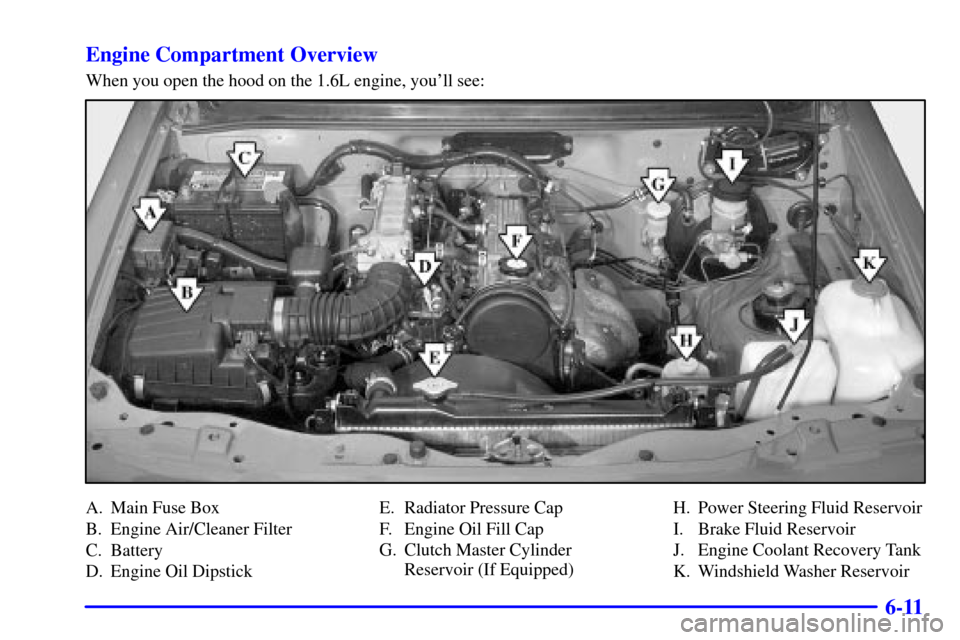
6-11 Engine Compartment Overview
When you open the hood on the 1.6L engine, you'll see:
A. Main Fuse Box
B. Engine Air/Cleaner Filter
C. Battery
D. Engine Oil DipstickE. Radiator Pressure Cap
F. Engine Oil Fill Cap
G. Clutch Master Cylinder
Reservoir (If Equipped)H. Power Steering Fluid Reservoir
I. Brake Fluid Reservoir
J. Engine Coolant Recovery Tank
K. Windshield Washer Reservoir
Page 264 of 391
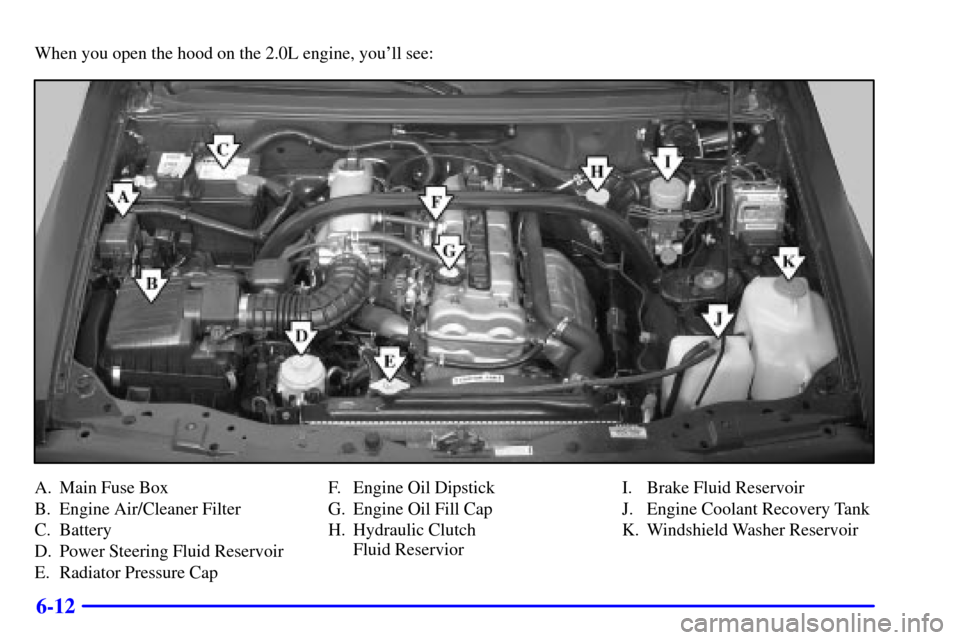
6-12
When you open the hood on the 2.0L engine, you'll see:
A. Main Fuse Box
B. Engine Air/Cleaner Filter
C. Battery
D. Power Steering Fluid Reservoir
E. Radiator Pressure CapF. Engine Oil Dipstick
G. Engine Oil Fill Cap
H. Hydraulic Clutch
Fluid ReserviorI. Brake Fluid Reservoir
J. Engine Coolant Recovery Tank
K. Windshield Washer Reservoir
Page 265 of 391
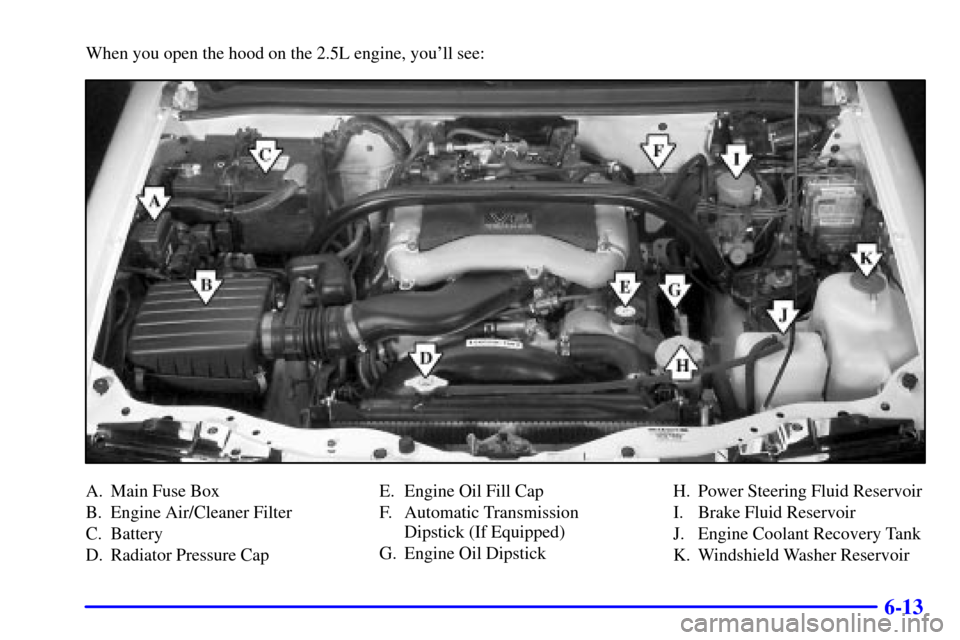
6-13
When you open the hood on the 2.5L engine, you'll see:
A. Main Fuse Box
B. Engine Air/Cleaner Filter
C. Battery
D. Radiator Pressure CapE. Engine Oil Fill Cap
F. Automatic Transmission
Dipstick (If Equipped)
G. Engine Oil DipstickH. Power Steering Fluid Reservoir
I. Brake Fluid Reservoir
J. Engine Coolant Recovery Tank
K. Windshield Washer Reservoir
Page 266 of 391

6-14
Engine Oil
If the engine oil pressure
light appears on the
instrument panel, it means
you need to check your
engine oil level right away.
For more information, see ªEngine Oil Pressure Lightº
in the Index.
You should check your engine oil level regularly; this is
an added reminder.
Checking Engine Oil
It's a good idea to check your engine oil every time you
get fuel. In order to get an accurate reading, the oil must
be warm and the vehicle must be on level ground.
The handle of the
engine oil dipstick is a
round, yellow ring. On
the 1.6L engine, it is
located near the front
of the engine
compartment towards
the passenger's side of
the vehicle.
1.6L Engine
Page 267 of 391
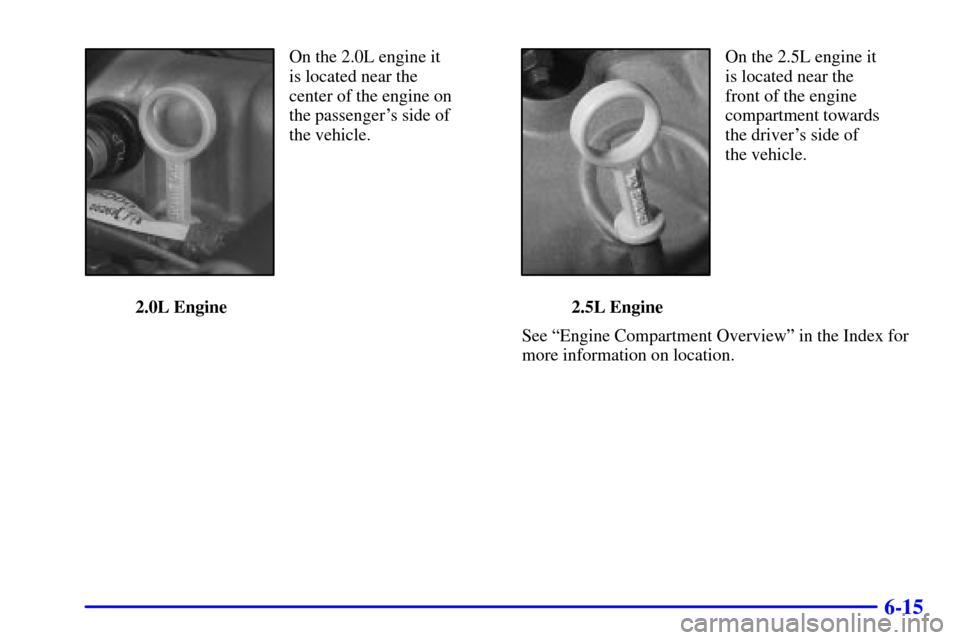
6-15
On the 2.0L engine it
is located near the
center of the engine on
the passenger's side of
the vehicle.
2.0L EngineOn the 2.5L engine it
is located near the
front of the engine
compartment towards
the driver's side of
the vehicle.
2.5L Engine
See ªEngine Compartment Overviewº in the Index for
more information on location.
Page 268 of 391
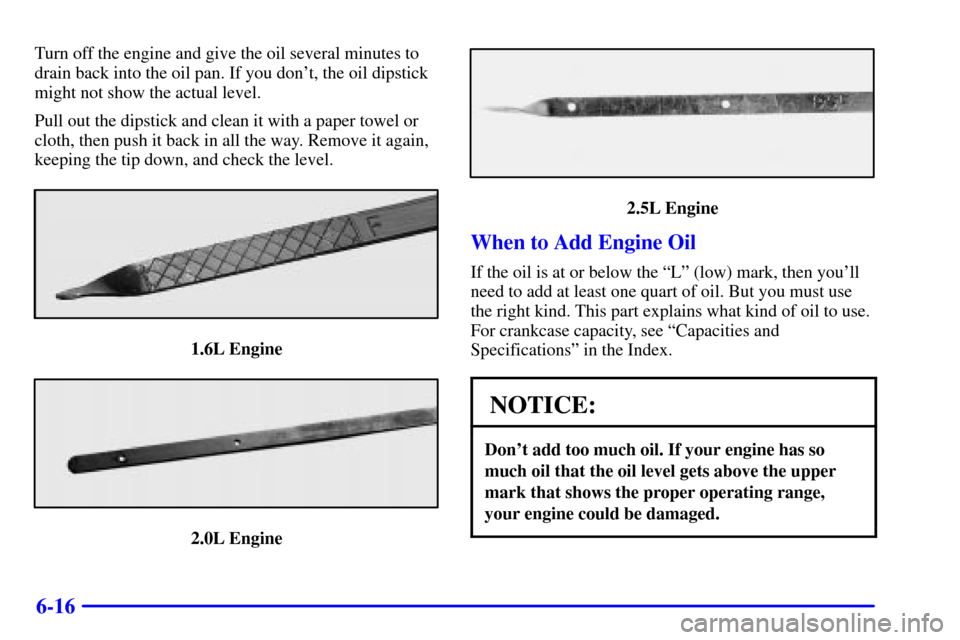
6-16
Turn off the engine and give the oil several minutes to
drain back into the oil pan. If you don't, the oil dipstick
might not show the actual level.
Pull out the dipstick and clean it with a paper towel or
cloth, then push it back in all the way. Remove it again,
keeping the tip down, and check the level.
1.6L Engine
2.0L Engine
2.5L Engine
When to Add Engine Oil
If the oil is at or below the ªLº (low) mark, then you'll
need to add at least one quart of oil. But you must use
the right kind. This part explains what kind of oil to use.
For crankcase capacity, see ªCapacities and
Specificationsº in the Index.
NOTICE:
Don't add too much oil. If your engine has so
much oil that the oil level gets above the upper
mark that shows the proper operating range,
your engine could be damaged.
Page 269 of 391
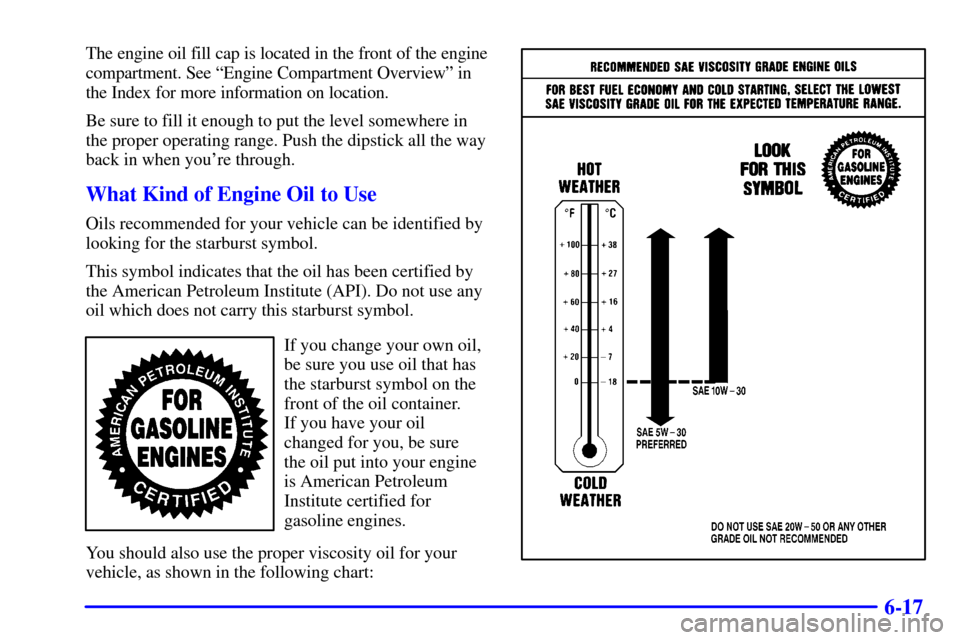
6-17
The engine oil fill cap is located in the front of the engine
compartment. See ªEngine Compartment Overviewº in
the Index for more information on location.
Be sure to fill it enough to put the level somewhere in
the proper operating range. Push the dipstick all the way
back in when you're through.
What Kind of Engine Oil to Use
Oils recommended for your vehicle can be identified by
looking for the starburst symbol.
This symbol indicates that the oil has been certified by
the American Petroleum Institute (API). Do not use any
oil which does not carry this starburst symbol.
If you change your own oil,
be sure you use oil that has
the starburst symbol on the
front of the oil container.
If you have your oil
changed for you, be sure
the oil put into your engine
is American Petroleum
Institute certified for
gasoline engines.
You should also use the proper viscosity oil for your
vehicle, as shown in the following chart: